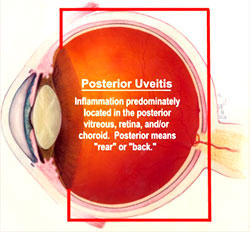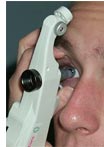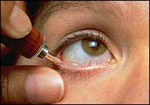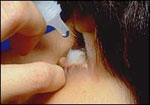|
|
Uveitis (Iritis)
Uveitis is an
inflammation of the the uvea, the layer between the sclera and the retina, which
includes the iris, ciliary body, and the choroid.
 Structure of
Eye
Structure of
Eye
The eye is a
3-layered ball, the outer layer is the sclera, a tough coat, the innermost is
the retina, the thin light-gathering layer, and the middle layer is the Uvea.
The Uvea is made up of the iris, the ciliary body and the choroid.
The iris is the colored structure surrounding the pupil, visible in the front of
the eye. The ciliary body is a structure containing muscle and is located behind
the iris which focuses the lens. The choroid is a layer containing blood vessels
that line the back of the eye and is
 located between the inner visually
sensitive layer, called the retina. The uvea provides
most of the blood supply to the retina. located between the inner visually
sensitive layer, called the retina. The uvea provides
most of the blood supply to the retina.
Inflammation in
uveitis may involve any but not necessarily all of these three structures.
Depending upon which structures are inflamed, uveitis may be further
subcategorized into one of three main diagnoses, these include:
-
Iritis or
anterior uveitis,
-
Iridocyclitis
or intermediate uveitis, and
-
Choroiditis or
posterior uveitis.
 Causes
Causes
It may result from
an infection such as a virus (e.g. herpes) or a fungus (e.g. histoplasmosis). It
may be due to a parasite such as toxoplasmosis.
It may be related
to
Autoimmune Disease
This, essentially, is when our
immune system recognizes a part of our own body
as
foreign. Trauma to the eye,
or even the other eye in the past, can lead to Uveitis. In many cases the cause
is said to be unknown. This may well mean that the Uveitis is of the autoimmune
type.
Uveitis, can lead
to other ocular complications, which may produce vision loss, including
glaucoma,
cataracts, or retinal damage. Early detection and treatment is
necessary to reduce the risk of permanent vision loss.
 Symptoms
Symptoms
Depending on which
part of the eye is inflammed in uveitis different combinations of these
 symptoms may be
present. symptoms may be
present.
-
Redness
-
Light
sensitivity
-
-
Blurry vision
-
Pain
 How is uveitis
diagnosed?
How is uveitis
diagnosed?
A careful eye
examination by an ophthalmologist is extremely important when symptoms occur.
Inflammation inside the eye can permanently affect sight or even lead to
blindness, if not treated. important when symptoms occur.
Inflammation inside the eye can permanently affect sight or even lead to
blindness, if not treated.
Your ophthalmologist will examine the inside of your eye. He or she may order
blood tests, skin tests or x-rays to help make the diagnosis.
Since uveitis can be associated with disease of the rest of the body, your
ophthalmologist will want to know about your overall health. He of she may want
to consult with your primary care physician or other medical specialists.
 Treatment
Treatment
Like the varied
nature of uveitis, the treatment of it may differ from case to case quite
considerably.
The treatment of
Uveitis aims to achieve the following:
-
Relief of
pain and discomfort (where present) - Your eye doctor
dilates, or enlarges, your pupil with eyedrops to relax your iris and relieve
your pain. Dilating your pupils increases your sensitivity to light, so you
may need to wear sunglasses for a few days. Your eye doctor may give you
eyedrops, ointments, or oral medications to reduce swelling. Be sure you
understand how to use these medications. eye doctor
dilates, or enlarges, your pupil with eyedrops to relax your iris and relieve
your pain. Dilating your pupils increases your sensitivity to light, so you
may need to wear sunglasses for a few days. Your eye doctor may give you
eyedrops, ointments, or oral medications to reduce swelling. Be sure you
understand how to use these medications.
-
To prevent
sight loss due to the disease or its complications
-
To treat the
cause of the disease where possible- Often the cause of
uveitis isn�t known, and your eye doctor can only treat the symptoms. If the
cause is known, treatment will depend on the underlying condition. Your eye
doctor may refer you to your primary care doctor or another specialist for
evaluation and treatment.
 Iritis is usually
mild. Pain caused by spasm of the pupil constriction muscle is relieved by drops
to dilate the pupil. Dark glasses may be helpful. Steroid eye drops or ointment
may be needed. More severe cases require a search for an underlying cause. Iritis is usually
mild. Pain caused by spasm of the pupil constriction muscle is relieved by drops
to dilate the pupil. Dark glasses may be helpful. Steroid eye drops or ointment
may be needed. More severe cases require a search for an underlying cause.
Pars planitis is
often treated with steroid eye drops, but may be treated with oral steroids or
another type of medication to suppress the immune system.
Choroiditis
requires determination of the underlying cause, and treatment of the underlying
disease. The underlying disease may be serious, and additional specialists in
infectious disease or autoimmunity may be needed for such diseases as
syphilis,
tuberculosis, AIDS, sarcoidosis (an
inflammatory disease characterized by
granulomas that can produce many
different symptoms) or Behcet's syndrome be serious, and additional specialists in
infectious disease or autoimmunity may be needed for such diseases as
syphilis,
tuberculosis, AIDS, sarcoidosis (an
inflammatory disease characterized by
granulomas that can produce many
different symptoms) or Behcet's syndrome
 Prevention
Prevention
Treating any underlying disorders may help to prevent uveitis for some
people with existing systemic diseases.
Related Links
|
|
|
|
|









